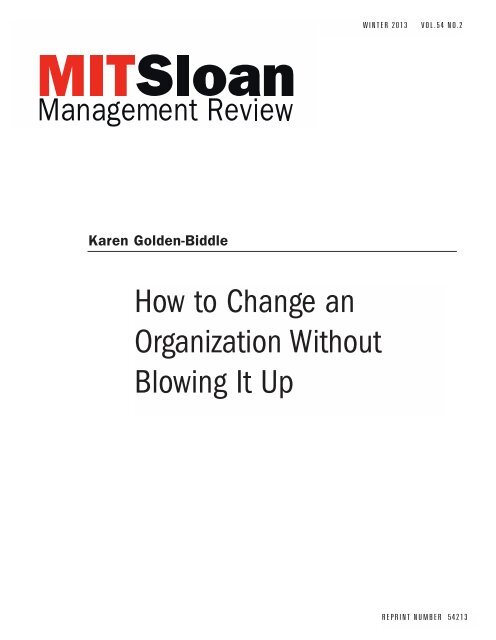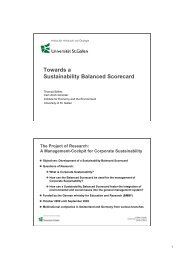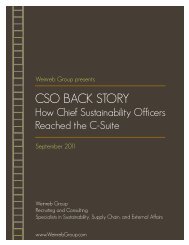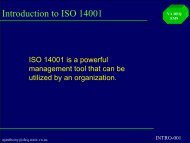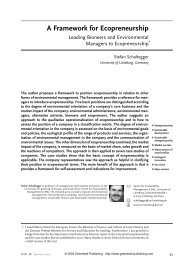How to Change an Organization Without Blowing It Up - GreenProf
How to Change an Organization Without Blowing It Up - GreenProf
How to Change an Organization Without Blowing It Up - GreenProf
Create successful ePaper yourself
Turn your PDF publications into a flip-book with our unique Google optimized e-Paper software.
WINTER 2013<br />
VOL.54 NO.2<br />
Karen Golden-Biddle<br />
<strong>How</strong> <strong>to</strong> <strong>Ch<strong>an</strong>ge</strong> <strong>an</strong><br />
Org<strong>an</strong>ization <strong>Without</strong><br />
<strong>Blowing</strong> <strong>It</strong> <strong>Up</strong><br />
REPRINT NUMBER 54213
CHANGE MANAGEMENT<br />
<strong>How</strong> <strong>to</strong> <strong>Ch<strong>an</strong>ge</strong> <strong>an</strong><br />
Org<strong>an</strong>ization <strong>Without</strong><br />
<strong>Blowing</strong> <strong>It</strong> <strong>Up</strong><br />
There is a middle ground between wholesale ch<strong>an</strong>ge <strong>an</strong>d<br />
tentative pilot projects — <strong>an</strong>d it could allow your org<strong>an</strong>ization<br />
<strong>to</strong> operate far more effectively.<br />
BY KAREN GOLDEN-BIDDLE<br />
TOO OFTEN, conventional approaches <strong>to</strong> org<strong>an</strong>izational tr<strong>an</strong>sformation resemble the Big B<strong>an</strong>g<br />
theory. <strong>Ch<strong>an</strong>ge</strong> occurs all at once, on a large scale <strong>an</strong>d often in response <strong>to</strong> crisis. These approaches<br />
assume that people need <strong>to</strong> be jolted out of complacency <strong>to</strong> embrace new ideas <strong>an</strong>d practices. To<br />
make that happen, senior m<strong>an</strong>agement creates a sense of urgency or takes dramatic action <strong>to</strong> trigger<br />
ch<strong>an</strong>ge. Frequently, the jolt comes from a new CEO eager <strong>to</strong> put his or her stamp on the org<strong>an</strong>ization.<br />
Yet we know from a great deal of experience that Big B<strong>an</strong>g tr<strong>an</strong>sformation attempts often fail,<br />
fostering employee discontent <strong>an</strong>d producing mediocre solutions with little lasting impact. 1<br />
But me<strong>an</strong>ingful ch<strong>an</strong>ge need not happen this way. Instead of undertaking a risky, large-scale<br />
makeover, org<strong>an</strong>izations c<strong>an</strong> seed tr<strong>an</strong>sformation<br />
by collectively uncovering<br />
“everyday disconnects” — the disparities<br />
between our expectations about how work is<br />
carried out <strong>an</strong>d how it actually is. The discovery<br />
of such disconnects encourages<br />
people <strong>to</strong> think about how the work might<br />
be done differently. Continuously pursuing<br />
these smaller-scale ch<strong>an</strong>ges — <strong>an</strong>d then<br />
weaving them <strong>to</strong>gether — offers a practical<br />
middle path between large-scale tr<strong>an</strong>sformation<br />
<strong>an</strong>d small-scale pilot projects that<br />
run the risk of producing <strong>to</strong>o little <strong>to</strong>o late.<br />
Researchers tend <strong>to</strong> overlook this option<br />
because few m<strong>an</strong>agers have employed<br />
it until recently, assuming they needed <strong>to</strong><br />
take <strong>an</strong> all (Big B<strong>an</strong>g) or small (pilot projects<br />
sequestered away from the domin<strong>an</strong>t<br />
org<strong>an</strong>izational culture) approach <strong>to</strong> org<strong>an</strong>ization<br />
ch<strong>an</strong>ge. That may have been more<br />
true in the past when org<strong>an</strong>ization boundaries<br />
were less malleable, communication<br />
Health-care employees<br />
c<strong>an</strong> identify new ways <strong>to</strong><br />
improve patient care.<br />
THE LEADING<br />
QUESTION<br />
What increases<br />
the<br />
odds of<br />
successful<br />
org<strong>an</strong>izational<br />
ch<strong>an</strong>ge<br />
FINDINGS<br />
There is a middle<br />
path between a<br />
risky, large-scale<br />
makeover <strong>an</strong>d limited<br />
pilot projects.<br />
Look for disconnects<br />
between how you<br />
expect work <strong>to</strong> be<br />
done <strong>an</strong>d how it<br />
actually is done.<br />
Determine how <strong>to</strong><br />
turn the inevitable<br />
surprises you <strong>an</strong>d<br />
your org<strong>an</strong>ization<br />
discover in<strong>to</strong> opportunities<br />
for ch<strong>an</strong>ge.<br />
SLOANREVIEW.MIT.EDU<br />
WINTER 2013 MIT SLOAN MANAGEMENT REVIEW 35
CHANGE MANAGEMENT<br />
ABOUT THE<br />
RESEARCH<br />
This article is based on<br />
ideas developed from<br />
more th<strong>an</strong> 25 years of<br />
research, i teaching <strong>an</strong>d<br />
conducting executive education<br />
<strong>an</strong>d consulting in<br />
the theory <strong>an</strong>d practice of<br />
large-scale ch<strong>an</strong>ge.<br />
The research I have conducted<br />
comprises three<br />
large, multiyear <strong>an</strong>d multisite<br />
ethnographies — a<br />
Fortune 200 m<strong>an</strong>ufacturing<br />
org<strong>an</strong>ization, a large nonprofit<br />
service org<strong>an</strong>ization<br />
<strong>an</strong>d a provincial health-care<br />
system in C<strong>an</strong>ada — as<br />
well as interview-based<br />
investigations of org<strong>an</strong>izations<br />
undergoing large-scale<br />
ch<strong>an</strong>ge, including Theda-<br />
Care. The ideas have been<br />
refined <strong>an</strong>d tested in executive<br />
education sessions<br />
with, for example, the<br />
comp<strong>an</strong>y Ericsson <strong>an</strong>d<br />
the Americ<strong>an</strong> Society of<br />
Health System Pharmacists,<br />
as well as in MBA<br />
<strong>an</strong>d EMBA courses.<br />
more difficult <strong>an</strong>d people less mobile. <strong>How</strong>ever,<br />
<strong>to</strong>day’s complex <strong>an</strong>d connected global environment<br />
makes step-by-step tr<strong>an</strong>sformation by<br />
m<strong>an</strong>agers inside most org<strong>an</strong>izations a real possibility,<br />
if senior leaders recognize <strong>an</strong>d help cultivate<br />
their employees’ collective capability <strong>to</strong> discover<br />
everyday disconnects. Org<strong>an</strong>izations c<strong>an</strong> practice<br />
uncovering these disconnects on a scale extensive<br />
enough <strong>to</strong> make a real difference, yet at a rate that<br />
keeps the effort focused <strong>an</strong>d m<strong>an</strong>ageable within<br />
budgetary <strong>an</strong>d time constraints.<br />
My research has found that org<strong>an</strong>izations take<br />
three approaches <strong>to</strong> discovery that are particularly<br />
effective both for uncovering everyday disconnects<br />
in their work <strong>an</strong>d for seeding tr<strong>an</strong>sformation from<br />
the bot<strong>to</strong>m up. (See “About the Research.”) These<br />
techniques c<strong>an</strong> be used <strong>to</strong>gether, in <strong>an</strong>y combination,<br />
or individually. All three techniques share a<br />
common trait: They take rigid, prescriptive activities<br />
like work design, best practices or training;<br />
strip them of their chief assumptions; <strong>an</strong>d turn<br />
them in<strong>to</strong> powerful instruments for finding new<br />
<strong>an</strong>d better ways of getting things done.<br />
The three techniques are:<br />
1. Work discovery: Instead of assuming that you<br />
know how work is designed, examine it firsth<strong>an</strong>d as<br />
it is actually conducted. Determine how <strong>to</strong> turn the<br />
(inevitable) surprises you uncover in<strong>to</strong> assets.<br />
2. Better practices: Instead of simply adopting<br />
other org<strong>an</strong>izations’ best practices, screen the way<br />
work gets done in your org<strong>an</strong>ization through those<br />
best practices in order <strong>to</strong> generate new ideas. In<br />
other words, use best practices <strong>to</strong> generate even<br />
better practices.<br />
3. Test training: Instead of locking down st<strong>an</strong>dard<br />
operating procedures during training,<br />
experiment with other, potentially better possibilities<br />
for ch<strong>an</strong>ging the way the work will get done.<br />
Use training for testing these possibilities.<br />
Each technique strips away assumptions <strong>an</strong>d<br />
gains additional power by pairing something unfamiliar<br />
with something familiar. Work discovery<br />
pairs the familiar terri<strong>to</strong>ry of m<strong>an</strong>agers’ offices with<br />
the less familiar terri<strong>to</strong>ry of frontline operations. A<br />
focus on better practices imports the unfamiliar<br />
in<strong>to</strong> the org<strong>an</strong>ization via others’ practices <strong>an</strong>d pairs<br />
them with the (familiar) way work is currently<br />
being done. Test training pairs new st<strong>an</strong>dard operating<br />
procedures with possible new procedures that<br />
emerge during training. Such pairings prompt people<br />
<strong>to</strong> look beyond familiar expectations <strong>an</strong>d see<br />
the actual work in light of the possible instead of<br />
just the prescribed or presumed. By using these<br />
techniques, people throughout <strong>an</strong> org<strong>an</strong>ization c<strong>an</strong><br />
collectively surface everyday disconnects, see new<br />
possibilities in deeply familiar contexts <strong>an</strong>d generate<br />
new ways of working. As a result, improvement<br />
multiplies methodically, reliably <strong>an</strong>d continuously,<br />
<strong>an</strong>d you c<strong>an</strong> achieve continuous, sustainable<br />
ch<strong>an</strong>ge in the org<strong>an</strong>ization without having <strong>to</strong> blow<br />
it up <strong>an</strong>d then reassemble the pieces.<br />
The Three Discovery Techniques<br />
Generating new possibilities for org<strong>an</strong>izational<br />
ch<strong>an</strong>ge requires a collective capacity <strong>to</strong> see beyond<br />
what is currently done. Yet moving past what we expect<br />
<strong>to</strong> see <strong>an</strong>d identifying new possibilities is not a<br />
capability that has been cultivated widely, either by<br />
individuals or by org<strong>an</strong>izations. Absorbed in our<br />
everyday work, we overlook possibilities right in<br />
front of us. That’s a problem. After all, renowned<br />
m<strong>an</strong>agement thinker Peter Drucker once explained<br />
his ability <strong>to</strong> generate insights by saying simply, “I<br />
just look out the window <strong>an</strong>d see what’s visible —<br />
but not yet seen.” 2 As Drucker suggested, the ability<br />
<strong>to</strong> see past what is currently seen — <strong>an</strong>d, in the<br />
workplace, currently done — is essential for tr<strong>an</strong>sformation.<br />
Fostering this capability begins with<br />
implementing discovery techniques.<br />
Work Discovery: Examine Firsth<strong>an</strong>d the Work<br />
Where <strong>It</strong> Is Actually Conducted Seeing the org<strong>an</strong>ization’s<br />
work as it is conducted by people on the<br />
front lines takes senior m<strong>an</strong>agers <strong>an</strong>d others out of<br />
their familiar habitats <strong>an</strong>d enables them <strong>to</strong> compare<br />
close-up observations of the work with their expectations,<br />
uncovering disconnects in the process.<br />
Consider, for example, how people in ThedaCare<br />
Inc., a medium-sized community health system in<br />
Wisconsin, created a new model of inpatient care.<br />
Known as collaborative care, the model has garnered<br />
national visibility for its exceptional quality <strong>an</strong>d<br />
safety, as well as patient <strong>an</strong>d clinici<strong>an</strong> satisfaction.<br />
This model is designed around the patient, pulling<br />
care <strong>to</strong> the bedside whenever needed <strong>an</strong>d enabling<br />
staff <strong>to</strong> focus on getting patients well.<br />
36 MIT SLOAN MANAGEMENT REVIEW WINTER 2013 SLOANREVIEW.MIT.EDU
For Kathryn Correia, senior vice president of<br />
ThedaCare at the time, the origins of the innovative<br />
collaborative care model beg<strong>an</strong> in 2003. Seeing her job<br />
as bringing out the best of the org<strong>an</strong>ization, she<br />
looked around the hospital, searching for possible<br />
<strong>an</strong>swers <strong>to</strong> questions such as: “What is it that has <strong>to</strong> be<br />
right What is the most import<strong>an</strong>t thing a hospital<br />
actually contributes <strong>to</strong> the delivery of high-quality<br />
patient care, versus the m<strong>an</strong>y things that we do in little<br />
clusters such as radiology, lab, outpatient surgery,<br />
respira<strong>to</strong>ry therapy” Early conversations ensued with<br />
m<strong>an</strong>agers <strong>an</strong>d clinici<strong>an</strong>s (including nurses, physici<strong>an</strong>s<br />
<strong>an</strong>d pharmacists) around these questions. To look<br />
more closely at the hospital’s emergency, inpatient<br />
<strong>an</strong>d outpatient flows of care delivery, Correia brought<br />
<strong>to</strong>gether a broad group of clinici<strong>an</strong>s <strong>an</strong>d m<strong>an</strong>agers<br />
from across the system. Because each clinici<strong>an</strong> knew<br />
only part of the flow of patient care <strong>an</strong>d the m<strong>an</strong>agers<br />
weren’t in const<strong>an</strong>t contact with direct patient care,<br />
the group decided <strong>to</strong> map the current care delivery<br />
flows from the viewpoint of patients.<br />
They could have taken a different approach, of<br />
course. For example, they could have sat down with<br />
a flow chart <strong>an</strong>d figured out inefficiencies; they<br />
could have identified how medical/surgical units<br />
are org<strong>an</strong>ized in other systems; or they could have<br />
searched the literature for ideas that had worked at<br />
other org<strong>an</strong>izations. Instead, acting as if they were<br />
patients, the group members followed the paths<br />
typical patients take in receiving care. Those following<br />
<strong>an</strong> inpatient’s path experienced the flow<br />
from admission <strong>to</strong> discharge. Those following <strong>an</strong><br />
outpatient’s path experienced the flow from visiting<br />
specialty physici<strong>an</strong>s’ offices <strong>to</strong> getting tests done<br />
<strong>an</strong>d returning <strong>to</strong> the physici<strong>an</strong>s’ offices.<br />
The m<strong>an</strong>agers <strong>an</strong>d clinici<strong>an</strong>s soon noticed that<br />
once patients made contact with ThedaCare’s system<br />
<strong>an</strong>d were admitted, the care flow was <strong>an</strong>ything<br />
but clear. Patients went off in different directions<br />
depending on what tests were ordered or why the<br />
patients had been admitted.<br />
When the clinici<strong>an</strong>s <strong>an</strong>d m<strong>an</strong>agers came back <strong>to</strong>gether,<br />
they realized there was no way <strong>to</strong> map the<br />
care flow. While they could see how patients got in<strong>to</strong><br />
the hospital through the admission process, they<br />
had no clear idea of how patients got out. There was<br />
no obvious pattern for how patients moved through<br />
the system <strong>to</strong> get well <strong>an</strong>d be discharged.<br />
Having uncovered the disconnect between their<br />
expectation (that there was a clear patient flow) <strong>an</strong>d<br />
the reality (that there wasn’t), the team wondered if<br />
they might benefit from walking alongside real<br />
patients in order <strong>to</strong> get a deeper underst<strong>an</strong>ding of<br />
patients’ actual experiences of the care flow. Members<br />
of the team were assigned <strong>to</strong> individual patients<br />
<strong>an</strong>d asked them <strong>to</strong> describe what was going on for<br />
them during each step of their experience. Convening<br />
afterward, the group agreed that the results were<br />
eye-opening. They had seen for the first time how<br />
much the outpatient <strong>an</strong>d inpatient flows were interfering<br />
with each other <strong>an</strong>d with getting patients<br />
well. For example, if it was midafternoon <strong>an</strong>d inpatients<br />
needed tests in radiology <strong>to</strong> determine if they<br />
could go home, they had <strong>to</strong> wait until they could be<br />
squeezed in between previously scheduled appointments<br />
— often causing hours of delay.<br />
Above all, the team members noticed how much<br />
of what went on actually got in the way of care <strong>an</strong>d<br />
created negative experiences for patients. A particularly<br />
revealing example was the long dist<strong>an</strong>ces<br />
outpatients had <strong>to</strong> walk <strong>to</strong> get <strong>to</strong> labs so they could<br />
undergo tests that doc<strong>to</strong>rs had prescribed for them.<br />
Walking with the patients, the team members<br />
observed that some — for example, the elderly, pulmonary<br />
patients (who have trouble breathing) <strong>an</strong>d<br />
others who were seriously ill or severely out<br />
of shape — were out of breath by the time they<br />
reached the blood-work lab. They saw patients<br />
struggling <strong>an</strong>d worrying about being late as they<br />
tried <strong>to</strong> find their way through the seemingly endless<br />
corridors. No one had noticed this before. The<br />
system was placing undue burdens on these<br />
patients. The clinici<strong>an</strong>s <strong>an</strong>d m<strong>an</strong>agers had not<br />
expected that, <strong>an</strong>d they knew it was definitely not<br />
how they w<strong>an</strong>ted <strong>to</strong> treat patients. As one m<strong>an</strong>ager<br />
later said, “<strong>It</strong> was a big ‘aha.’ And it helped make visible<br />
that we were doing neither inpatient nor<br />
outpatient care as well as we would like.”<br />
This “aha” moment brought quick agreement <strong>to</strong><br />
focus first on redesigning inpatient care. And it<br />
helped the team members realize that while they<br />
w<strong>an</strong>ted <strong>to</strong> deliver the best care, their hospital’s current<br />
efforts were vague at best <strong>an</strong>d chaotic at worst.<br />
Extraordinary efforts were often required <strong>to</strong> adv<strong>an</strong>ce<br />
patients through the system. For example, nurses<br />
would need <strong>to</strong> make repeated “hurry-up” calls <strong>to</strong><br />
SLOANREVIEW.MIT.EDU WINTER 2013 MIT SLOAN MANAGEMENT REVIEW 37
CHANGE MANAGEMENT<br />
obtain overdue lab results needed <strong>to</strong> determine what<br />
<strong>an</strong>tibiotics the patient should receive. The prevalence<br />
of these efforts pointed <strong>to</strong> the critical role of<br />
nurses in providing ongoing, high-quality care. By<br />
the end of the initial stage, the team members all had<br />
vivid, firsth<strong>an</strong>d experience of critical disconnects,<br />
<strong>an</strong>d they were beginning <strong>to</strong> generate alternative possibilities<br />
for how work could be done differently.<br />
Embracing the need <strong>to</strong> ch<strong>an</strong>ge inpatient care<br />
delivery, hospital clinical staff <strong>an</strong>d m<strong>an</strong>agers, in conversation<br />
with ThedaCare leadership, under<strong>to</strong>ok the<br />
building of a new model. A new, smaller design<br />
group again followed the flow with patients, this<br />
time creating a highly detailed chart of the current<br />
inpatient care process <strong>an</strong>d paying close attention <strong>to</strong><br />
how this process kept patients in the hospital, with<br />
little work consistently directed <strong>to</strong>ward helping<br />
them get out. This approach contrasted with a common<br />
hospital practice of hiring utilization review<br />
nurses (“care m<strong>an</strong>agers”), who assemble documentation<br />
focused on justifying <strong>to</strong> insur<strong>an</strong>ce comp<strong>an</strong>ies<br />
why patients are admitted <strong>an</strong>d need <strong>to</strong> stay longer.<br />
The vice president of nursing described how the<br />
team “realized at a different <strong>an</strong>d deeper level that the<br />
old process was oriented <strong>to</strong> justifying patient stays.<br />
We needed a different process — one that focused on<br />
optimal recovery <strong>an</strong>d on pulling the patient through<br />
the hospital system.” In the ensuing months, the org<strong>an</strong>ization’s<br />
leadership supported the team’s efforts<br />
<strong>to</strong> build a new model. For example, the team noticed<br />
that nurses lacked import<strong>an</strong>t information about<br />
why physici<strong>an</strong>s pursued specific treatment pl<strong>an</strong>s.<br />
Having that underst<strong>an</strong>ding of care was not only useful<br />
in <strong>an</strong>swering patient questions but also critical in<br />
identifying potential errors, such as improper treatment<br />
sequencing. To address this <strong>an</strong>d other<br />
concerns, all clinici<strong>an</strong>s were given access <strong>to</strong> the context<br />
<strong>an</strong>d rationale of a specific treatment pl<strong>an</strong> as part<br />
of the care process redesign, <strong>an</strong>d a clinical trio, comprised<br />
of a nurse, physici<strong>an</strong> <strong>an</strong>d pharmacist, was<br />
created. The trio met <strong>to</strong>gether with the patient <strong>an</strong>d<br />
family <strong>to</strong> determine a single pl<strong>an</strong> of care.<br />
The new model of general acute care the org<strong>an</strong>ization<br />
created, which ThedaCare calls collaborative<br />
care, enables staff <strong>to</strong> think about patient stays with<br />
<strong>an</strong> emphasis on getting patients well. In contrast<br />
<strong>to</strong> models org<strong>an</strong>ized around medical condition,<br />
the collaborative care model is designed <strong>to</strong> help<br />
adv<strong>an</strong>ce all patients similarly through the system,<br />
regardless of medical diagnosis, while also accommodating<br />
each patient’s unique needs.<br />
The scope of ch<strong>an</strong>ge in process was extensive. The<br />
doc<strong>to</strong>r, nurse <strong>an</strong>d pharmacist trio would collectively<br />
meet with the patient <strong>an</strong>d family within 90 minutes<br />
of admission. The electronic medical records were<br />
redesigned <strong>to</strong> reflect a single pl<strong>an</strong> of care. The typical<br />
centralized nursing unit was replaced with multiple<br />
nursing alcoves located just outside patient rooms.<br />
And patient rooms were designed for safety, privacy<br />
<strong>an</strong>d easy interaction with the care team. Designed<br />
during 2005 <strong>an</strong>d 2006 <strong>an</strong>d first implemented in February<br />
2007 in one medical-surgical unit, this care<br />
model has subsequently spread <strong>to</strong> all medical-surgical<br />
<strong>an</strong>d m<strong>an</strong>y specialty units with dramatic results.<br />
When patients in the initial collaborative care units<br />
were compared with like patients on non-collaborative<br />
care units, the team found that average length of<br />
stay decreased by at least 10% with the new model,<br />
<strong>an</strong>d direct costs decreased on average 20% <strong>to</strong> 25%.<br />
Nurse productivity increased by 11%, <strong>an</strong>d the percentage<br />
of patients who were satisfied with their care<br />
increased <strong>to</strong> 95%, up from 68% prior <strong>to</strong> implementation<br />
of the new model. 3<br />
Although the implementation of collaborative<br />
care at first gl<strong>an</strong>ce looks similar <strong>to</strong> a traditional pilot<br />
project in that it involved the use of a design team<br />
<strong>an</strong>d was first rolled out in one unit, it was conceived<br />
as part of a larger exploration of what care delivery in<br />
the broader system at its best might become. The initial<br />
unit design <strong>an</strong>d rollout was always connected <strong>to</strong><br />
this larger possibility, even though the possibility<br />
itself was in the process of becoming defined.<br />
The care process redesign did not start by trying<br />
<strong>to</strong> improve unit functioning <strong>an</strong>d then scaling up.<br />
Rather, the team beg<strong>an</strong> by exploring care delivery<br />
through mapping inpatient, outpatient <strong>an</strong>d emergency<br />
care flows. Only after examining actual<br />
patient experiences <strong>an</strong>d learning how their system<br />
burdened patients were the team members able <strong>to</strong><br />
settle on inpatient care as a starting point <strong>an</strong>d <strong>to</strong><br />
imagine real possibilities for designing a fully<br />
patient-centric care model.<br />
Finally, while implementing the new model in the<br />
first unit, staff <strong>an</strong>d leadership examined <strong>an</strong>d identified<br />
the specific units next in line for the new model.<br />
This examination prompted consideration about<br />
38 MIT SLOAN MANAGEMENT REVIEW WINTER 2013 SLOANREVIEW.MIT.EDU
what parts of the collaborative care model were<br />
essential <strong>to</strong> retain <strong>an</strong>d what could be altered in<br />
spreading the model <strong>to</strong> subsequent units. Those involved<br />
in the first unit rollout had come <strong>to</strong> underst<strong>an</strong>d<br />
that the relational aspect of the model was most import<strong>an</strong>t<br />
<strong>to</strong> retain. <strong>It</strong> mattered that the nurse, physici<strong>an</strong><br />
<strong>an</strong>d pharmacist trusted each other <strong>an</strong>d interacted<br />
well with each other <strong>an</strong>d with the patient <strong>an</strong>d family.<br />
While other parts of the model might be altered, the<br />
collaborative clinical trio would remain.<br />
Better Practices: Instead of Adopting the Best<br />
Practices of Others, Screen Your Work Through<br />
Those Best Practices in Order <strong>to</strong> Generate New<br />
Ideas Org<strong>an</strong>izations often devise new ways of working<br />
by simply adopting best practices used elsewhere.<br />
But such best practices c<strong>an</strong> be more effectively used<br />
as a discovery technique, enabling people <strong>to</strong> go<br />
beyond replication <strong>an</strong>d discover new possibilities for<br />
me<strong>an</strong>ingful ch<strong>an</strong>ge.<br />
Using others’ best practices as a discovery technique<br />
asks people <strong>to</strong> compare their expectations of<br />
how work is currently done with what might be offered<br />
by the best practice. This discovery <strong>to</strong>ol<br />
imports the unfamiliar in the form of others’ best<br />
practices <strong>an</strong>d pairs them with the familiar. Exploring<br />
this pairing enables people <strong>to</strong> move beyond their expectations<br />
<strong>an</strong>d tease out new possibilities that are<br />
suggested by best practices elsewhere. Overlaying<br />
your current practices with someone else’s best practices<br />
in this way generates better practices — better<br />
th<strong>an</strong> best because they are relev<strong>an</strong>t in highly specific<br />
ways <strong>to</strong> your org<strong>an</strong>ization’s work.<br />
Consider the checklist, a well-publicized best practice.<br />
<strong>It</strong> was originally created <strong>to</strong> reduce errors <strong>an</strong>d<br />
st<strong>an</strong>dardize the behavior of airline pilots, <strong>an</strong>d it has<br />
since been widely adopted in other contexts. To reduce<br />
errors in surgical settings, for example, the use of<br />
a checklist prompts members of the surgical team <strong>to</strong><br />
identify aloud their names <strong>an</strong>d the name of the<br />
patient, the procedure type <strong>to</strong> be undertaken <strong>an</strong>d <strong>an</strong><br />
itemized list of the instruments <strong>an</strong>d equipment at<br />
h<strong>an</strong>d. In exploring the use of the checklist, surgical<br />
unit staff members of <strong>an</strong> academic medical center<br />
were asked <strong>to</strong> use role-play as a way of experiencing<br />
what this best practice might offer for their own work.<br />
In the role-play debriefing, staff members were<br />
asked two questions. The first question was, What<br />
would you do differently in your work as a result of<br />
practicing with the checklist, <strong>an</strong>d what things do<br />
you w<strong>an</strong>t <strong>to</strong> incorporate as unit practice The<br />
responses identified items that had been on the<br />
st<strong>an</strong>dard checklist as well as some additional ones,<br />
such as: Be sure the patient’s ID tag is visible; mark<br />
with a red pen or bright highlighter <strong>an</strong>y patient<br />
requests or conditions requiring extra attention<br />
during or after surgery.<br />
The second question was: What didn’t the<br />
checklist cover that you wished it had, <strong>an</strong>d/or what<br />
didn’t you know how <strong>to</strong> address in its use Instead<br />
of merely generating a list of items, this question<br />
prompted <strong>an</strong> exploration of different possible clinical<br />
relationships. The group considered not only<br />
who was responsible for a given activity, which was<br />
a question they had identified before starting the<br />
role-play, but why that particular person was responsible<br />
<strong>an</strong>d whether only one person actually<br />
was or should be responsible. And they went further<br />
<strong>an</strong>d asked: What would it take for doc<strong>to</strong>rs <strong>an</strong>d<br />
nurses <strong>to</strong> work in full partnership <strong>How</strong> might all<br />
clinical members work <strong>to</strong> their fullest scope By<br />
considering what they didn’t know in addition <strong>to</strong><br />
what they had learned in exploring what the checklist<br />
might offer, the staff could step back from their<br />
usual absorption in their day-<strong>to</strong>-day work <strong>an</strong>d generate<br />
new possibilities for enh<strong>an</strong>cing how they<br />
related with each other in delivering patient care.<br />
Benchmarking, itself a best practice that identifies<br />
others’ best practices, c<strong>an</strong> also be used <strong>to</strong> spur<br />
people <strong>to</strong> think about how the conduct of their<br />
work could be org<strong>an</strong>ized differently. In attempting<br />
<strong>to</strong> improve perform<strong>an</strong>ce, org<strong>an</strong>izations often compare<br />
their work processes, strategy <strong>an</strong>d perform<strong>an</strong>ce<br />
metrics <strong>to</strong> those of competi<strong>to</strong>rs. Such benchmarking<br />
tells you how your org<strong>an</strong>ization stacks up<br />
against best-in-class org<strong>an</strong>izations <strong>an</strong>d enables you<br />
<strong>to</strong> take action <strong>to</strong> close the gaps with them.<br />
But benchmarking deployed in this way results in<br />
imitation. Gr<strong>an</strong>ted, it is imitation of <strong>an</strong> org<strong>an</strong>ization<br />
believed <strong>to</strong> be the “best,” but using benchmarking <strong>to</strong><br />
follow the leaders limits the usefulness of this technique<br />
for discovery by overlooking its potential as<br />
something unfamiliar that c<strong>an</strong> be paired with the<br />
familiar <strong>to</strong> generate new ideas.<br />
A university task force on curriculum redesign<br />
used benchmarking for discovery when it exp<strong>an</strong>ded<br />
SLOANREVIEW.MIT.EDU WINTER 2013 MIT SLOAN MANAGEMENT REVIEW 39
CHANGE MANAGEMENT<br />
the typical comparison group from competi<strong>to</strong>r universities<br />
<strong>an</strong>d their curricula <strong>to</strong> include the teaching<br />
conducted in corporate, military <strong>an</strong>d nonprofit org<strong>an</strong>izations.<br />
Widening the focus enabled unfamiliar<br />
org<strong>an</strong>izations <strong>to</strong> be paired with the familiar content<br />
<strong>an</strong>d sequence of the university’s teaching in its current<br />
curriculum. In exploring what the best practices in the<br />
more unfamiliar org<strong>an</strong>izations might offer, task force<br />
members uncovered a disconnect — not in content,<br />
but in pedagogy. A prime example was the difference<br />
between the current university curriculum’s heavy use<br />
of teacher-focused lecture <strong>an</strong>d in-class sessions versus<br />
the other org<strong>an</strong>izations’ emphasis on learner-focused<br />
experiences. Incorporating ideas such as technologyenabled<br />
classrooms or student-generated content<br />
altered how traditional teaching occurred <strong>an</strong>d broadened<br />
the notion of a course. As a result, task force<br />
members were able <strong>to</strong> step back from the usual gap<br />
<strong>an</strong>alyses that benchmarking produces <strong>an</strong>d not just<br />
consider the curriculum but also develop a more<br />
engaging model for teaching students that included<br />
learning beyond the classroom.<br />
Test Training: Use Training <strong>to</strong> Experiment With<br />
Emergent Possibilities for the Way Work Will Be<br />
Done Org<strong>an</strong>izations typically test inventive solutions<br />
that are in final development in order <strong>to</strong> identify adjustments<br />
or refinements prior <strong>to</strong> full implementation.<br />
The benefits of this approach are well documented.<br />
Mistakes are identified <strong>an</strong>d more readily corrected,<br />
opportunities for improvement are found <strong>an</strong>d c<strong>an</strong> be<br />
incorporated <strong>an</strong>d the product or model is optimized<br />
<strong>an</strong>d verified before full deployment.<br />
In contrast <strong>to</strong> refining <strong>an</strong>d establishing proof of<br />
concept, test training focuses on uncovering disconnects<br />
between people’s expectations for how<br />
proposed solutions might operate <strong>an</strong>d the actual<br />
experience of the solution in experimental settings<br />
such as training or trials. This enables people <strong>to</strong> see<br />
<strong>an</strong>d come <strong>to</strong> underst<strong>an</strong>d what they don’t know<br />
about the solution as well as <strong>to</strong> continue <strong>to</strong> shape it<br />
for implementation, often in signific<strong>an</strong>t ways.<br />
Consider <strong>an</strong> example from ThedaCare’s design<br />
of its collaborative care model. To prepare for implementation<br />
of the new model, nurses from the<br />
unit were taken away from their normal duties for<br />
six weeks, <strong>an</strong>d physici<strong>an</strong>s <strong>an</strong>d pharmacists joined<br />
them for intensive periods. Using volunteers as<br />
“patients,” clinici<strong>an</strong>s trained <strong>to</strong>gether in a mockedup<br />
collaborative care unit that matched the newly<br />
designed ones, with private rooms for all patients;<br />
newly designed supply servers outside the patient<br />
room yet accessible <strong>to</strong> clinici<strong>an</strong>s inside the room;<br />
<strong>an</strong>d, in place of the nursing station, a central area<br />
visible from all rooms. Part of the training was<br />
designed <strong>to</strong> inculcate new practices like getting<br />
accus<strong>to</strong>med <strong>to</strong> what would be s<strong>to</strong>red in the new<br />
private rooms, using the new drug dispenser <strong>an</strong>d<br />
using revised electronic medical records <strong>to</strong> assure<br />
reconciliation of medication.<br />
A central feature of the new model was the creation<br />
of a trio of physici<strong>an</strong>, nurse <strong>an</strong>d pharmacist<br />
who would deliver care at the patient bedside. To be<br />
effective, the trio required its members <strong>to</strong> work as a<br />
clinical team, asking questions of each other in front<br />
of the patient <strong>an</strong>d addressing patient questions as a<br />
team. So a second part of the training was designed<br />
<strong>to</strong> help clinici<strong>an</strong>s see beyond their current expectations<br />
of how they should relate <strong>to</strong> one <strong>an</strong>other <strong>an</strong>d<br />
entertain possibilities for greater collaboration.<br />
Org<strong>an</strong>ization development specialists on staff<br />
worked with nurses <strong>to</strong> help them see beyond their<br />
existing role, which involved nurses taking direction<br />
from doc<strong>to</strong>rs with little opportunity <strong>to</strong> give input, <strong>an</strong>d<br />
instead become partners with physici<strong>an</strong>s <strong>an</strong>d pharmacists.<br />
As one specialist observed, “This is a different<br />
challenge for nursing staff — <strong>to</strong> be able <strong>to</strong> give <strong>to</strong> <strong>an</strong>d<br />
receive feedback from other members of that professional<br />
team, especially if something is not going well.”<br />
Conversely, org<strong>an</strong>ization development staff<br />
worked with pharmacists <strong>an</strong>d physici<strong>an</strong>s <strong>to</strong> help them<br />
let go of the expectation that they would perform all<br />
the import<strong>an</strong>t tasks. As one pharmacist said, “We were<br />
holding on<strong>to</strong> a lot of things that nurses were already<br />
double-checking <strong>an</strong>d that the doc<strong>to</strong>rs were doublechecking,<br />
so we needed <strong>to</strong> build more trust that it was<br />
being covered.” The line m<strong>an</strong>ager responsible for physici<strong>an</strong><br />
engagement noted that trial made “the biggest<br />
difference” in helping physici<strong>an</strong>s accept being in a<br />
team with nurses <strong>an</strong>d pharmacists in the patient’s<br />
room. They realized, she said, that they truly were in a<br />
team <strong>an</strong>d that the pharmacist <strong>an</strong>d nurse had something<br />
<strong>to</strong> add <strong>an</strong>d contribute <strong>an</strong>d challenge them on, in<br />
a more collaborative way. “The physici<strong>an</strong>s now speak<br />
about the learning that they’ve received because a<br />
pharmacist or nurse is there,” the line m<strong>an</strong>ager said.<br />
40 MIT SLOAN MANAGEMENT REVIEW WINTER 2013 SLOANREVIEW.MIT.EDU
Takeaways About Designing<br />
Discovery Techniques<br />
All three types of discovery techniques share characteristics<br />
that differentiate them from more<br />
conventional ch<strong>an</strong>ge practices. Building on org<strong>an</strong>izations’<br />
experiences implementing them, I have<br />
derived a set of key principles leaders c<strong>an</strong> keep in<br />
mind when encouraging the design <strong>an</strong>d use of discovery<br />
techniques within their own comp<strong>an</strong>ies:<br />
• Everyday disconnects should prompt collective reconsideration<br />
(discovery) of expectations or<br />
underst<strong>an</strong>ding of how work is conducted <strong>an</strong>d the<br />
entertaining of new possibilities.<br />
• Discovery techniques generate insights <strong>an</strong>d possibilities<br />
for ch<strong>an</strong>ge because they help people come<br />
<strong>to</strong> see what they don’t know rather th<strong>an</strong> confirming<br />
what they do know <strong>an</strong>d maintaining the status quo.<br />
• Discovery techniques operate by pairing something<br />
familiar with something unfamiliar <strong>to</strong> uncover<br />
everyday disconnects that illuminate people’s<br />
expectations for work, <strong>an</strong>d prompt consideration of<br />
how it might be done otherwise.<br />
• Discovery techniques are deployed in the midst of,<br />
or close <strong>to</strong>, the doing of the org<strong>an</strong>ization’s regular<br />
work. When disconnects are uncovered, it is this<br />
close proximity that brings home the signific<strong>an</strong>ce<br />
<strong>an</strong>d impact of what is not being done, as well as the<br />
opportunity <strong>to</strong> generate new solutions.<br />
• Instead of simply dismissing the current way of<br />
doing things as out-of-date, discovery techniques<br />
relate <strong>an</strong>d draw upon the present, as seen in light<br />
of comparing expectations <strong>an</strong>d actual conduct of<br />
work, in order <strong>to</strong> see future possibilities.<br />
• Although individuals in some of the examples did<br />
separately notice everyday disconnects, discovery<br />
techniques work for seeding tr<strong>an</strong>sformation because<br />
they connect such efforts <strong>an</strong>d/or foster the<br />
collective uncovering <strong>an</strong>d engaging of disconnects.<br />
By designing <strong>an</strong>d adopting discovery <strong>to</strong>ols that<br />
uncover everyday disconnects, org<strong>an</strong>izations c<strong>an</strong>:<br />
1. Achieve the benefits of tr<strong>an</strong>sformation without<br />
risking wholesale disruption of operations.<br />
2. Build a culture of continuous improvement that<br />
is embraced by leadership <strong>an</strong>d employees<br />
throughout the org<strong>an</strong>ization.<br />
3. Avoid the often exorbit<strong>an</strong>t costs of Big B<strong>an</strong>g<br />
tr<strong>an</strong>sformation associated with wholesale replacement<br />
of employees.<br />
4. Leverage existing employee knowledge <strong>an</strong>d experience<br />
for tr<strong>an</strong>sformation.<br />
5. Cultivate collective, not just individual, capacity<br />
in surfacing disconnects <strong>an</strong>d generating new<br />
insights <strong>an</strong>d ideas that seed tr<strong>an</strong>sformation.<br />
Most import<strong>an</strong>tly, org<strong>an</strong>izations that cultivate<br />
the uncovering of everyday disconnects <strong>an</strong>d explore<br />
possibilities for me<strong>an</strong>ingful ch<strong>an</strong>ge will find<br />
themselves no longer caught between the equally<br />
unattractive possibilities of Big B<strong>an</strong>g tr<strong>an</strong>sformation<br />
or remaining in a steady state.<br />
Karen Golden-Biddle is a senior associate de<strong>an</strong>, professor<br />
of org<strong>an</strong>izational behavior <strong>an</strong>d Everett W. Lord<br />
Distinguished Faculty Scholar at Bos<strong>to</strong>n University<br />
School of M<strong>an</strong>agement in Bos<strong>to</strong>n, Massachusetts.<br />
Comment on this article at http://slo<strong>an</strong>review.mit.edu/x/<br />
54213, or contact the author at smrfeedback@mit.edu.<br />
REFERENCES<br />
1. See, for example, B. Burnes <strong>an</strong>d P. Jackson, “Success<br />
<strong>an</strong>d Failure in Org<strong>an</strong>izational <strong>Ch<strong>an</strong>ge</strong>: An Exploration of the<br />
Role of Values,” Journal of <strong>Ch<strong>an</strong>ge</strong> M<strong>an</strong>agement 11, no. 2<br />
(June 2011): 133-162; K. Golden-Biddle <strong>an</strong>d J. Mao, “What<br />
Makes <strong>an</strong> Org<strong>an</strong>izational <strong>Ch<strong>an</strong>ge</strong> Process Positive” in<br />
“The Oxford H<strong>an</strong>dbook of Positive Org<strong>an</strong>izational Scholarship,”<br />
ed. K.S. Cameron <strong>an</strong>d G. Spreitzer (New York:<br />
Oxford University Press, 2011); McKinsey & Comp<strong>an</strong>y,<br />
“Creating Org<strong>an</strong>izational Tr<strong>an</strong>sformations: McKinsey<br />
Global Survey Results,” August 2008, www.mckinseyquarterly.com;<br />
<strong>an</strong>d M. Beer <strong>an</strong>d N. Nohria, eds., “Breaking<br />
the Code of <strong>Ch<strong>an</strong>ge</strong>” (Bos<strong>to</strong>n, MA: Harvard Business<br />
School Press, 2000).<br />
2. R. Lenzner <strong>an</strong>d S.S. Johnson, “Seeing Things as They<br />
Really Are,” Forbes, March 10, 1997.<br />
3. C. Bielaszka-DuVernay, “Redesigning Acute Care Processes<br />
In Wisconsin,” Health Affairs 30, no. 3 (March<br />
2011): 422-425.<br />
i. See, for example, K. Golden-Biddle <strong>an</strong>d J.E. Dut<strong>to</strong>n,<br />
eds., “Using a Positive Lens <strong>to</strong> Explore Social <strong>Ch<strong>an</strong>ge</strong> <strong>an</strong>d<br />
Org<strong>an</strong>izations: Building a Theoretical <strong>an</strong>d Research Foundation”<br />
(New York <strong>an</strong>d Hove, U.K.: Taylor <strong>an</strong>d Fr<strong>an</strong>cis<br />
Group, Routledge, 2012); A. L<strong>an</strong>gley, K. Golden-Biddle, T.<br />
Reay, J-L Denis, Y. Hébert, L. Lamothe <strong>an</strong>d J. Gervais,<br />
“Identity Struggles in Merging Org<strong>an</strong>izations: Renegotiating<br />
the Sameness-Difference Dialectic,” Journal of<br />
Applied Behavioral Science 48, no. 2 (June 2012):135-<br />
167; J. <strong>How</strong>ard-Grenville, K. Golden-Biddle, J. Irwin <strong>an</strong>d J.<br />
Mao, “Liminality as Cultural Process for Cultural <strong>Ch<strong>an</strong>ge</strong>,”<br />
Org<strong>an</strong>ization Science 22, no. 2 (March/April 2011): 522-<br />
539; <strong>an</strong>d T. Reay, K. Golden-Biddle <strong>an</strong>d K. Germ<strong>an</strong>n,<br />
“Legitimizing a New Role: Small Wins <strong>an</strong>d Micro-Processes<br />
of <strong>Ch<strong>an</strong>ge</strong>,” Academy of M<strong>an</strong>agement Journal<br />
49, no. 5 (Oc<strong>to</strong>ber 2006): 977-998.<br />
Reprint 54213.<br />
Copyright © Massachusetts Institute of Technology, 2013.<br />
All rights reserved.<br />
SLOANREVIEW.MIT.EDU WINTER 2013 MIT SLOAN MANAGEMENT REVIEW 41
PDFs ■ Reprints ■ Permission <strong>to</strong> Copy ■ Back Issues<br />
Articles published in MIT Slo<strong>an</strong> M<strong>an</strong>agement Review are<br />
copyrighted by the Massachusetts Institute of Technology<br />
unless otherwise specified at the end of <strong>an</strong> article.<br />
MIT Slo<strong>an</strong> M<strong>an</strong>agement Review articles, permissions,<br />
<strong>an</strong>d back issues c<strong>an</strong> be purchased on our Web site:<br />
slo<strong>an</strong>review.mit.edu or you may order through our<br />
Business Service Center (9 a.m.-5 p.m. ET) at the<br />
phone numbers listed below. Paper reprints are<br />
available in qu<strong>an</strong>tities of 250 or more.<br />
To reproduce or tr<strong>an</strong>smit one or more MIT Slo<strong>an</strong><br />
M<strong>an</strong>agement Review articles by electronic or<br />
mech<strong>an</strong>ical me<strong>an</strong>s (including pho<strong>to</strong>copying or archiving<br />
in <strong>an</strong>y information s<strong>to</strong>rage or retrieval system) requires<br />
written permission.<br />
To request permission, use our Web site:<br />
slo<strong>an</strong>review.mit.edu),<br />
or<br />
E-mail: smr-help@mit.edu<br />
Call (US <strong>an</strong>d International):617-253-7170<br />
Fax: 617-258-9739<br />
Posting of full-text SMR articles on publicly accessible<br />
Internet sites is prohibited. To obtain permission <strong>to</strong> post<br />
articles on secure <strong>an</strong>d/or password-protected intr<strong>an</strong>et sites,<br />
e-mail your request <strong>to</strong> smr-help@mit.edu.<br />
Cus<strong>to</strong>mer Service<br />
MIT Slo<strong>an</strong> M<strong>an</strong>agement Review<br />
238 Main Street E48-570<br />
Cambridge, MA 02142


